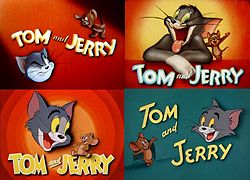

The pair was not seen again until the series Tom and Jerry Tales, produced by Warner Bros. The film was met with poor critical and box-office reception. Tom and Jerry were back to being friends, as they were in the '70s, and they spoke regularly, sang and danced together. The film was distributed by H-B but made by an outside studio. In 1993, the characters starred in their first feature-length film, Tom and Jerry: The Movie. Spike and his son Tyke (who now had talking dialogue) and Droopy and his son Dripple, appeared in back-up segments for the show, which ran until 18 November 1994. The animation was improved over the more recent incarnations, but the violence was still watered down, since the series was aimed at younger viewers. As with the 1975 H-B series, Jerry wears his red bowtie, while Tom now wears a red cap. It featured kid versions of the famous cat-and-mouse duo chasing each other.

Hanna-Barbera was back at the helm for this version. In 1990, another incarnation of the characters appeared, this time as Tom and Jerry Kids. In 1986, MGM's pre-1986 film library was purchased by Ted Turner, thus Tom and Jerry became the property of Turner Entertainment Co. (where the rights stand today via Warner Bros.), and have in subsequent years appeared on Turner-run stations, such as TBS, TNT, Cartoon Network, The WB, Boomerang, and Turner Classic Movies. These cartoons were often criticized for their limited animation and canned music. The characters were back to chasing each other, though the violence was very toned down. In 1980, the pair returned to Saturday morning under the guidance of the Filmation studio. Jerry also sported a red bow tie to give animators room to fragment his movements. They were now friends, and traveled around the country getting in various innocuous adventures. Due to pressure by family watchdog groups, Tom and Jerry no longer fought with each other.
Tom and jerry episodes 2013 tv#
The first original TV show would debut in 1975 and be co-produced by Hanna-Barbera. Reruns of Tom and Jerry shorts aired weekly on CBS Saturday (and later Sunday) from 1965 to 1972. Deitch's Tom and Jerry cartoons were heavily panned by critics and fans, mainly for their very low production quality. Gene Deitch released several theatrical shorts with the characters in the early 1960s, followed by Chuck Jones (of Looney Tunes fame). This would not the last appearance of new Tom and Jerry cartoons, however. This event caused Hanna and Barbera to form their own studio Hanna-Barbera.

The characters' cartoons were nominated for, and won, several Oscars before MGM shut the doors of its cartoon studio in 1957. The series also became widescreen CinemaScope-style in the 1950s. Tom's color palette even changed from a dark blue-grey to a much lighter grey, though Jerry remained brown. In the 1950s, the animation was simplified and stylized in the wake of similarly stylized cartoons from UPA, which were popular and acclaimed at the time. Cartoons director Tex Avery, who had joined the MGM cartoon studio in 1942.

By the mid-1940s, the series had developed a quicker, more energetic and violent tone, due to the inspiration from the works of former Warner Bros. By contrast, Jerry's design remained essentially the same for the duration of the series. In their very first appearances in the early-1940s, Tom looked more like a realistic cat with excess of detail-shaggy fur, numerous facial wrinkles, and multiple eyebrow markings evolving from his quadrupedal beginnings Tom to become increasingly and almost exclusively bipedal. The characters went through a few design changes over the years. The following short, The Midnight Snack (1941), introduced the cat-and-mouse duo with their current names. The series began following the success of the MGM one-shot Puss Gets the Boot (1940).


 0 kommentar(er)
0 kommentar(er)
